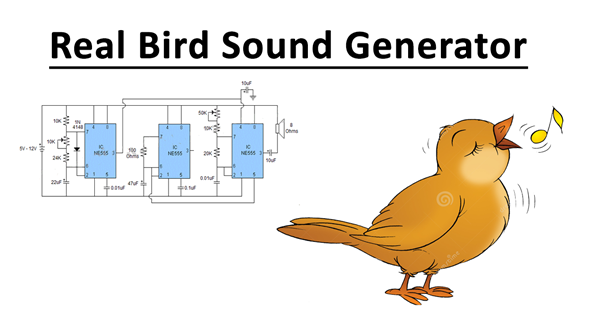The article describes a few simple oscillator circuits which are suitably dimensioned as different types of tone generators resembling the sounds of birds. The circuits are able to imitate bird sounds like that of a parrot, sparrow, and woodpecker.
Ever since electronics came into existence, humans have used its technological capabilities for imitating and enforcing many naturally happening phenomena for their own benefit and amusement. Moreover with the help of electronics, we have invented ways and succeeded to fulfill our fantasies through many overwhelming effects created through different audio visual electronic devices. Nature has always played a pivotal role behind most of the inspirations.
The present idea is also inspired from Mother Nature and the explained circuits are designed and dimensioned for generating close to bird like sound effects, like the chirping of sparrows, the shrieking of a parrot, or the wood pecking sound made by wood peckers etc. The circuits can be applied in door bells, toys, gift items, musical greeting cards, automobile horns, etc.
Music Generator Circuit Description
The first circuit shown here is configured to produce sounds imitating birds chirping . The circuit functioning can be understood with the following points:
Chirping Bird Sound Generator:
In a few of my previous posts, I discussed astable multivibrator (AMV) circuits and how these configurations are immensely versatile and provides wide application options. Here a couple of these AMVs are incorporated for creating the sound effects.
AMVs are basically oscillators which generate alternate high and low pulses. The frequency of these pulses is determined by the values of a few resistors and capacitors and also termed RC time constants.
In the present application the two AMVs are specified with the tasks of controlling the tone oscillations and switching oscillations respectively.

In the diagram the upper section defines the pitch of the tone while the lower design controls the length of the tone and its breaks.
Through a smart integration of a couple of resistors and a potentiometer the upper section is biased intermittently by the lower rate generator circuit, so that the tone generated by the upper section can be switched at a particular rate, shaping typical bird chirping effects. The pot may be varied for enhancing the tone so that it imitates the effect to near perfection. Another Pot VR2 is used for making the chirping rate faster or slower.
If the circuit is intended to be used as a door bell, the inclusion of the large capacitor 2000 µF becomes pretty handy. Once the bell push button is released, the capacitor allows the sound to persist for few seconds and gradually decays down instead of shutting off abruptly.
The generated tone is directly fed to a loudspeaker for the required reproduction.
Parrot Sound Generator:
A nice little electronic project in the form of a parrot voice generator circuit is illustrated here, which is especially suitable for new electronic enthusiasts as it hardly involves any complications.
Again the circuit is primarily configured as an audio oscillator having a “sweep” facility included. The facility enables the generated frequency to be automatically “swept” or altered across two set frequency limits.
Basically two output transformers are incorporated for creating frequencies responsible for the desired sound effects. However the, left hand side transformer and the transistor along with the associated components actually generate the parrot tone, the extreme right hand side transformer is used for stepping up the frequency potential so that the connected speaker at the secondary winding can be driven hard producing an amplified output.

Woodpecker Sound Generator
The circuit is a bit similar to the first circuit as it also includes a free running multivibrator circuit. The unit produces a “tick, tick” sound, resembling a wood pecker hitting a tree bark with its beak. The frequency of the “pecking” beats can be adjusted by the variable resistor for optimizing the sound effect as close as possible to its original counterpart.
Though it may not be a nature lover’s preference, the circuit can be further adjusted and modified for generating motor boat throttling sound effects also, if desired.
Pressing the push button initiates the sound effect generations, which gradually dies down until the 2200 uF capacitor has completely discharged.

Door Bell Application
“Chirping bird” or “parrot sound” doorbells are quite widely used in door bells, and the above circuits can be easily modified for these applications.
As we know door bells need to be light in weight, compact and yet operate reliably with AC mains voltage without getting damaged, which necessitates the use of a transformerless power supply to be included with them.
The figure shows a transformerless power supplysuitable for powering door bell applications and can be used for powering the above circuits.
The reactance of the PPC capacitor at the input is used for generating the necessary supply for operating the electronic circuit. The inclusion of the large value storage capacitor makes it sure that the “bird singing” continues for a while even after the unit is switched OFF. The capacitor can be avoided if it’s been included in the circuit of the particular tone generator.



